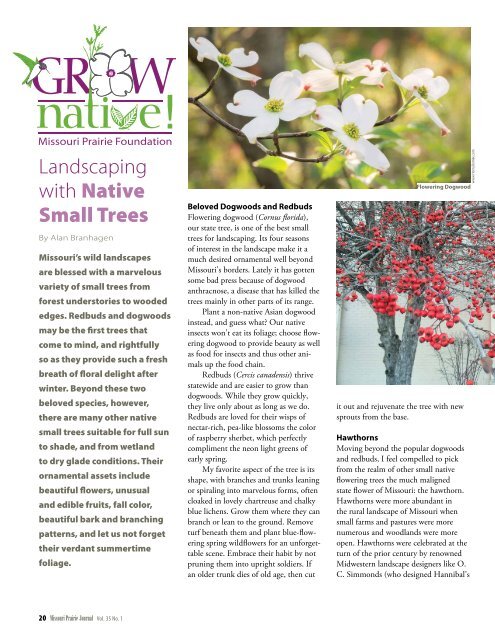l4c9lj6
l4c9lj6
l4c9lj6
Create successful ePaper yourself
Turn your PDF publications into a flip-book with our unique Google optimized e-Paper software.
Landscaping<br />
with Native<br />
Small Trees<br />
By Alan Branhagen<br />
Missouri’s wild landscapes<br />
are blessed with a marvelous<br />
variety of small trees from<br />
forest understories to wooded<br />
edges. Redbuds and dogwoods<br />
may be the first trees that<br />
come to mind, and rightfully<br />
so as they provide such a fresh<br />
breath of floral delight after<br />
winter. Beyond these two<br />
beloved species, however,<br />
there are many other native<br />
small trees suitable for full sun<br />
to shade, and from wetland<br />
to dry glade conditions. Their<br />
ornamental assets include<br />
beautiful flowers, unusual<br />
and edible fruits, fall color,<br />
beautiful bark and branching<br />
patterns, and let us not forget<br />
their verdant summertime<br />
foliage.<br />
Beloved Dogwoods and Redbuds<br />
Flowering dogwood (Cornus florida),<br />
our state tree, is one of the best small<br />
trees for landscaping. Its four seasons<br />
of interest in the landscape make it a<br />
much desired ornamental well beyond<br />
Missouri’s borders. Lately it has gotten<br />
some bad press because of dogwood<br />
anthracnose, a disease that has killed the<br />
trees mainly in other parts of its range.<br />
Plant a non-native Asian dogwood<br />
instead, and guess what? Our native<br />
insects won’t eat its foliage; choose flowering<br />
dogwood to provide beauty as well<br />
as food for insects and thus other animals<br />
up the food chain.<br />
Redbuds (Cercis canadensis) thrive<br />
statewide and are easier to grow than<br />
dogwoods. While they grow quickly,<br />
they live only about as long as we do.<br />
Redbuds are loved for their wisps of<br />
nectar-rich, pea-like blossoms the color<br />
of raspberry sherbet, which perfectly<br />
compliment the neon light greens of<br />
early spring.<br />
My favorite aspect of the tree is its<br />
shape, with branches and trunks leaning<br />
or spiraling into marvelous forms, often<br />
cloaked in lovely chartreuse and chalky<br />
blue lichens. Grow them where they can<br />
branch or lean to the ground. Remove<br />
turf beneath them and plant blue-flowering<br />
spring wildflowers for an unforgettable<br />
scene. Embrace their habit by not<br />
pruning them into upright soldiers. If<br />
an older trunk dies of old age, then cut<br />
Flowering Dogwood<br />
it out and rejuvenate the tree with new<br />
sprouts from the base.<br />
Hawthorns<br />
Moving beyond the popular dogwoods<br />
and redbuds, I feel compelled to pick<br />
from the realm of other small native<br />
flowering trees the much maligned<br />
state flower of Missouri: the hawthorn.<br />
Hawthorns were more abundant in<br />
the rural landscape of Missouri when<br />
small farms and pastures were more<br />
numerous and woodlands were more<br />
open. Hawthorns were celebrated at the<br />
turn of the prior century by renowned<br />
Midwestern landscape designers like O.<br />
C. Simmonds (who designed Hannibal’s<br />
www.HenryDomke.com<br />
20 Missouri Prairie Journal Vol. 35 No. 1


